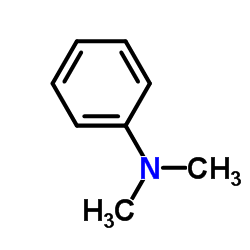N,N-Dimethylaniline

N,N-Dimethylaniline structure
|
Common Name | N,N-Dimethylaniline | ||
|---|---|---|---|---|
| CAS Number | 121-69-7 | Molecular Weight | 121.180 | |
| Density | 1.0±0.1 g/cm3 | Boiling Point | 193.5±0.0 °C at 760 mmHg | |
| Molecular Formula | C8H11N | Melting Point | 1.5-2.5 °C(lit.) | |
| MSDS | Chinese USA | Flash Point | 62.8±0.0 °C | |
| Symbol |



GHS06, GHS08, GHS09 |
Signal Word | Danger | |
|
Convenient QSAR model for predicting the complexation of structurally diverse compounds with β-cyclodextrins
Bioorg. Med. Chem. 17 , 896-904, (2009) This paper reports a QSAR study for predicting the complexation of a large and heterogeneous variety of substances (233 organic compounds) with beta-cyclodextrins (beta-CDs). Several different theoretical molecular descriptors, calculated solely from the mole... |
|
|
Calculating virtual log P in the alkane/water system (log P(N)(alk)) and its derived parameters deltalog P(N)(oct-alk) and log D(pH)(alk).
J. Med. Chem. 48 , 3269-79, (2005) Growing interest in the use of both the logarithm of the partition coefficient of the neutral species in the alkane/water system (log P(N)(alk)) and the difference between log P(N)(oct) (the logarithm of the partition coefficient of the neutral species in the... |
|
|
QUANTITY: An Isobaric Tag for Quantitative Glycomics.
Sci. Rep. 5 , 17585, (2015) Glycan is an important class of macromolecules that play numerous biological functions. Quantitative glycomics--analysis of glycans at global level--however, is far behind genomics and proteomics owing to technical challenges associated with their chemical pr... |
|
|
Imaging of N-linked glycans from formalin-fixed paraffin-embedded tissue sections using MALDI mass spectrometry.
ACS Chem. Biol. 9(9) , 2149-56, (2014) Aberrant glycosylation is associated with most of the diseases. Direct imaging and profiling of N-glycans on tissue sections can reveal tissue-specific and/or disease-associated N-glycans, which not only could serve as molecular signatures for diagnosis but a... |
|
|
Inter- and intra-organ spatial distributions of sea star saponins by MALDI imaging.
Anal. Bioanal. Chem 407 , 8813-24, (2015) Saponins are secondary metabolites that are abundant and diversified in echinoderms. Mass spectrometry is increasingly used not only to identify saponin congeners within animal extracts but also to decipher the structure/biological activity relationships of t... |
|
|
Effect of binder liquid type on spherical crystallization.
Drug Dev. Ind. Pharm. 40(11) , 1468-75, (2014) Spherical crystallization is a process of formation of agglomerates of crystals held together by binder liquid. This research focused on understanding the effect of type of solvents used as binder liquid on the agglomeration of crystals.Carbamazepine and etha... |
|
|
Redox inactive metal ion triggered N-dealkylation by an iron catalyst with dioxygen activation: a lesson from lipoxygenases.
Dalton Trans. 44 , 9847-59, (2015) Utilization of dioxygen as the terminal oxidant at ambient temperature is always a challenge in redox chemistry, because it is hard to oxidize a stable redox metal ion like iron(III) to its high oxidation state to initialize the catalytic cycle. Inspired by t... |
|
|
Molecularly imprinted polymer for specific extraction of hypericin from Hypericum perforatum L. herbal extract.
J. Pharm. Biomed. Anal. 98 , 210-20, (2014) The molecularly imprinted polymers (MIPs) were prepared by an oxidation-reduction polymerization system using a non-covalent molecularly imprinting strategy with hypericin as the template, acrylamide as the functional monomer and pentaerythritol triacrylate a... |
|
|
Carbon, hydrogen, and nitrogen isotope fractionation associated with oxidative transformation of substituted aromatic N-alkyl amines.
Environ. Sci. Technol. 46(13) , 7189-98, (2012) We investigated the mechanisms and isotope effects associated with the N-dealkylation and N-atom oxidation of substituted N-methyl- and N,N-dimethylanilines to identify isotope fractionation trends for the assessment of oxidations of aromatic N-alkyl moieties... |
|
|
Dipole effects on cation-pi interactions: absolute bond dissociation energies of complexes of alkali metal cations to N-methylaniline and N,N-dimethylaniline.
J. Phys. Chem. A 112(35) , 7996-8008, (2008) Threshold collision-induced dissociation of M (+)( nMA) x with Xe is studied using guided ion beam mass spectrometry, where nMA = N-methylaniline and N, N-dimethylaniline and x = 1 and 2. M (+) includes the following alkali metal cations: Li (+), Na (+), K (+... |